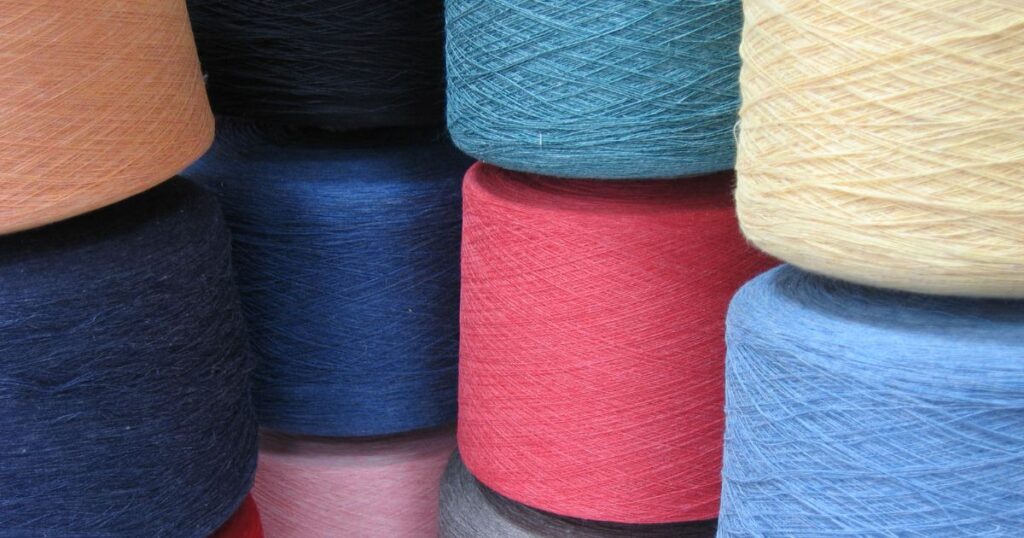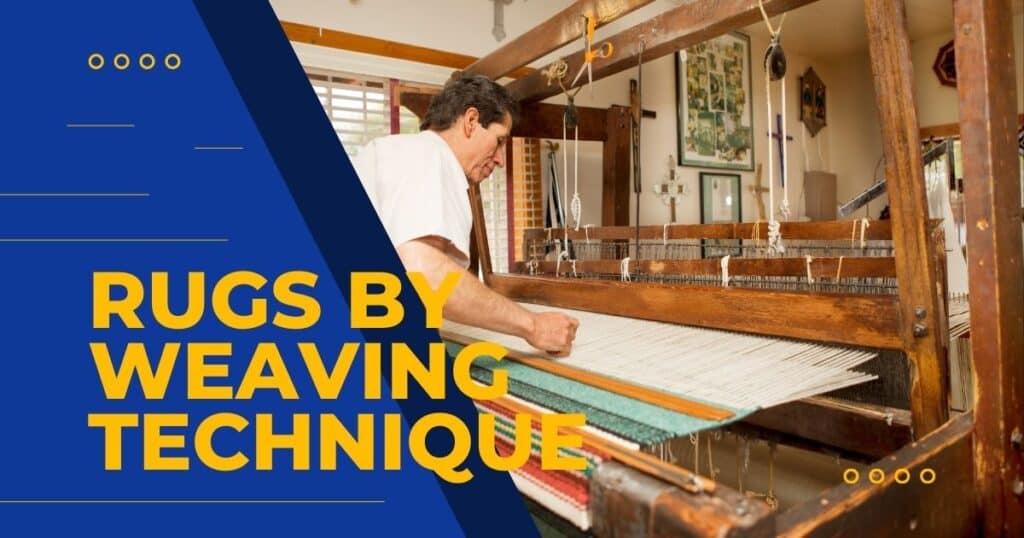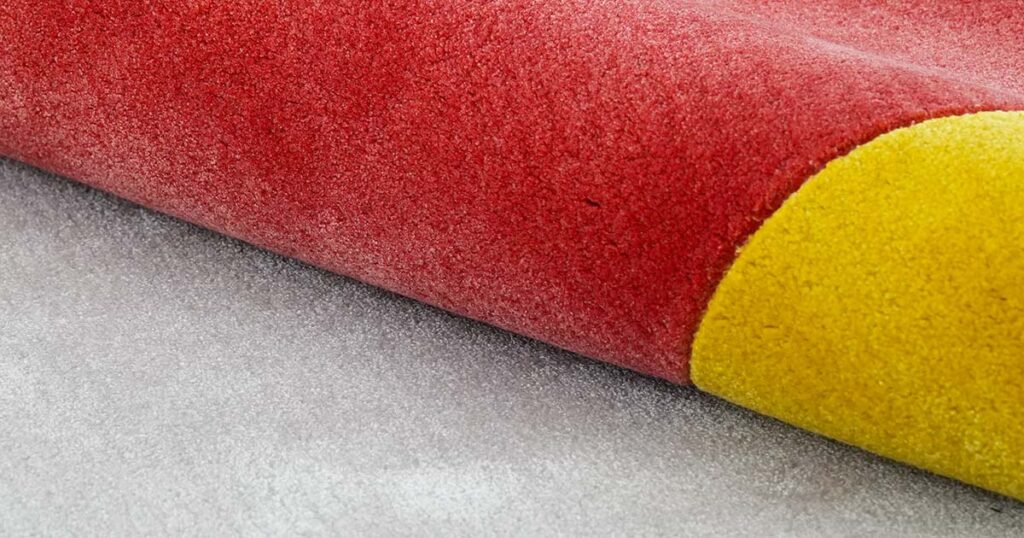When shopping for a new rug, you may encounter various fiber options, including rayon.
This comprehensive guide examines rayon tufted rugs in detail – what they are, their advantages and disadvantages, and how they compare to other common rug materials.
By the end, you’ll understand whether a rayon tufted rug is the right choice for your home.
Quick Summary
Rayon tufted rugs offer beautiful silk-like aesthetics at a more affordable price, but come with significant drawbacks in durability and maintenance.
They’re best suited for low-traffic, formal areas where their visual appeal can be appreciated without excessive wear.
What is Rayon?
Rayon is a semi-synthetic fiber made from regenerated cellulose, typically derived from wood pulp or cotton linters. Unlike synthetic fibers, rayon isn’t purely petrochemical; it’s made from natural cellulose that undergoes chemical processing.
The production process involves:
- Taking purified cellulose from wood or cotton
- Treating it with chemicals (like sodium hydroxide and carbon disulfide)
- Creating a viscous solution (hence the name “viscose” rayon)
- Forcing this solution through tiny holes (spinnerets)
- Forming filaments that solidify into fiber
- Spinning these fibers into yarn
The result is a fiber that mimics the luxurious look and feel of silk, which is why it’s sometimes called “art silk” (short for artificial silk) in the rug industry.
It’s important to understand that rayon sits in an interesting middle ground between natural and synthetic fibers.
While its base material is renewable cellulose and the final product is biodegradable like plant matter, the manufacturing process is highly chemical and industrial. This places rayon in a gray area that’s neither fully natural nor fully synthetic.
Types of Rayon
There are several types of rayon you might encounter when shopping for rugs:
- Traditional Viscose Rayon: The most common type, made using the viscose process described above
- Bamboo Silk: A type of rayon made from bamboo cellulose instead of wood pulp; marketed as more sustainable. Bamboo grows extremely fast (some species up to a meter a day), needs no replanting, and uses less water than cotton. Some manufacturers claim their bamboo silk is slightly more durable than standard viscose, though it shares most of the same limitations.
- Modal: A “second generation” rayon with enhanced properties, typically made from beech trees. Modal is stronger (especially when wet), more durable than regular rayon, and more resistant to shrinkage and fading.
- Tencel/Lyocell: A more eco-friendly form of rayon produced in a closed-loop system with less environmental impact. The closed-loop process recycles almost all the solvents used, making it substantially more eco-friendly than traditional viscose production. Tencel typically offers slightly better performance than standard viscose while maintaining the same aesthetic qualities.
Advantages of Rayon Rugs
Luxurious Silk-Like Aesthetics
Rayon’s biggest appeal is its beautiful silky appearance. The fibers are smooth and straight, giving a rug a gentle gleam that catches the light. This creates highlights and lowlights similar to real silk, often described as “lustrous” or “shimmery.” Even in a low pile, rayon provides an elegant sheen that elevates a rug’s appearance.
What makes rayon particularly interesting visually is its reflective quality. Similar to velvet, rayon creates a dynamic two-tone effect where a single-color rug can look lighter or darker from different angles in the room. This visual play of light adds dimension and interest to even solid-colored rugs. In patterned designs, this quality makes motifs pop and stand out with subtle brilliance.
Affordable Alternative to Silk
Real silk rugs are extremely expensive. Rayon offers a way to get a silk-like rug at a fraction of the cost. For consumers and designers, this means achieving a high-sheen, elegant rug within a moderate budget.
Excellent Color Potential
Rayon fibers accept dyes readily, resulting in vibrant, rich colors. The fiber’s translucence and sheen give colors lovely depth and variation depending on viewing angle. Similar to velvet, one side of the fiber catches light and appears lighter, while the other side appears darker in shadow, creating a dynamic visual effect.
Softness & Comfort
Rayon has a very soft, silky feel that’s gentle on the skin. Walking barefoot on a rayon tufted rug feels smooth with no coarseness. This makes it pleasant for areas where you might sit on the rug.
Designer Appeal
Because of its look, rayon often appears in high-style designer rugs. It can be carved or embossed in patterns to enhance light play. Using rayon immediately gives a rug a high-end showroom quality that appeals to those who prioritize appearance.
Disadvantages of Rayon Rugs
Poor Durability
Rayon is not a durable flooring fiber. It’s significantly weaker than most other rug fibers and loses about 50% of its strength when wet. The fibers have low resistance to abrasion and wear down quickly in high-traffic areas. Some sources note that rayon fibers can start to bend/break after as few as 70 footfalls in the same spot, compared to wool or nylon that can withstand thousands.
To put this in perspective, a typical hallway in a family home could show visible wear patterns in a rayon rug within weeks, not years. The rug will develop matted, shiny patches where walked on and may even begin “sprouting” – where individual fiber strands work loose from the pile. This weakness makes rayon rugs particularly unsuitable for homes with active children or large dogs, and especially problematic in entry areas, hallways, and busy living rooms.
Water Sensitivity
Perhaps the biggest practical issue with rayon rugs is their extreme sensitivity to moisture. Rayon is highly absorbent and weakens drastically when wet. A simple water spill can cause rayon fibers to kink up or harden, permanently changing texture. When wet and then dried, rayon often stiffens or yellows, leaving watermarks or stiff spots.
This sensitivity extends beyond obvious spills – even humidity can cause slight discoloration over time. What makes this particularly challenging is that water-based cleaning methods (which work for most other fibers) can actually worsen rayon’s appearance. A water spill that would be a minor inconvenience on wool can leave a permanent stain or textural change on rayon. Professional cleaners often find rayon rugs extremely tricky for this reason – they can’t use water-based cleaners liberally, and even solvent cleaning must be approached with caution. Even a glass of spilled water can leave a ring that’s impossible to fully remove.
Difficult Maintenance
Cleaning rayon rugs is challenging. They require professional cleaning by specialists familiar with cellulosic fibers. Even then, complete stain removal isn’t guaranteed, and the rug may lose luster after cleaning. For homeowners, this means being extremely careful – blotting spills immediately with a white cloth, never rubbing, and avoiding soaking the area.
Lack of Resilience
Rayon lacks resilience – the pile crushes easily under furniture or even footsteps and does not spring back. A heavy object will leave a permanent dent. Over time, expect a rayon rug to flatten in traffic areas, creating contrast between matted and untouched sections. Unlike wool, you can’t effectively revive a rayon pile with steam or brushing.
This poor “memory” means that furniture placement becomes semi-permanent – once you set a couch or table on a rayon rug, moving it will reveal compressed areas that won’t recover. High heels or sharp furniture edges can permanently indent or even cut the fibers. Within months of regular use, a rayon rug typically develops noticeable traffic patterns where the pile has flattened, creating a visual contrast between walked-on and untouched areas. This wear pattern is virtually impossible to reverse, as the fiber simply doesn’t have the structural memory to bounce back.
Shedding Tendency
Rayon rugs shed fibers, especially when new. Because the fiber isn’t very strong, vacuum beater bars can pull fibers out. Rayon also tends to “sprout,” where individual yarn strands work loose from the pile. These should be trimmed, not pulled.
Environmental Considerations
Production Impact
Traditional rayon production is chemical-intensive. The carbon disulfide used in processing has documented negative effects on workers and the environment. The classic viscose process produces significant chemical waste and can contribute to water pollution if not properly managed. Worker safety is also a concern due to exposure to toxic chemicals during manufacturing.
Sustainability Profile
Rayon presents a mixed environmental picture:
- Positives: Made from renewable cellulose sources; biodegrades eventually like plant matter; doesn’t come from fossil fuels; doesn’t shed microplastics in the environment (it sheds micro-cellulose fibers which biodegrade)
- Negatives: Chemical-intensive processing; potential pollution concerns; deforestation risks if wood pulp isn’t sustainably sourced
Some manufacturers have improved controls or moved to closed-loop processes.
If sustainability is a priority, look specifically for Tencel/lyocell rayon, which uses a more environmentally responsible production method that recycles solvents and minimizes waste.
Where to Use Rayon Rugs
Rayon is best suited for:
- Low-traffic areas: Adult bedrooms, formal living rooms, guest rooms
- Statement pieces: Where the rug is more for visual impact than utility
- Mixed-fiber rugs: Wool with rayon highlights balances durability with luxury appearance. These blends (typically 80% wool, 20% viscose) offer the visual pop of rayon with wool’s durability as a base
- Occasional use spaces: Formal areas that see infrequent traffic
Partially covered areas: For example, under a bed where only the edges are exposed to foot traffic - Wall hangings or decorative pieces: Some tufted rugs with rayon are actually used as wall decor (hung like tapestries) where they receive no foot traffic at all
Rayon is NOT recommended for:
- Hallways, entryways, or stairs
- Family rooms with active children or pets
- Dining areas or kitchens where spills are likely
- Bathrooms or humid environments
- Areas with direct sunlight, which can fade the fibers
- Under heavy furniture that will crush the pile permanently
- Commercial settings (with rare exceptions like very high-end hospitality where maintenance is meticulous and replacement is budgeted)
Rayon vs. Other Rug Fibers
Wool
Durability: Wool lasts decades; rayon wears quickly
Maintenance: Wool is easier to clean; rayon requires special care
Resilience: Wool springs back; rayon crushes permanently
Cost: Wool costs more initially but provides better value long-term
Look: Wool has a natural matte elegance; rayon has a silky sheen
Synthetic Fibers
Durability: Synthetics dramatically outperform rayon
Stain Resistance: Synthetics resist stains; rayon absorbs them
Moisture Handling: Synthetics can be cleaned with water; rayon cannot
Feel: Synthetics feel less luxurious than rayon
Environmental Impact: Both have drawbacks, but rayon biodegrades eventually
Real Silk
Look: Both have luxurious sheen, but real silk has unmatched depth
Durability: Real silk is more durable than rayon but still delicate
Cost: Silk costs many times more than rayon
Care: Both require special care and professional cleaning
Caring Rayon Rugs
If you choose a rayon rug, follow these care guidelines:
Preventative Measures
Place in low-traffic areas away from moisture sources
Use a rug pad underneath to reduce friction and wear
Consider a no-shoes policy to minimize abrasion and dirt
Keep away from direct sunlight to prevent fading
Avoid placing under heavy furniture that will crush pile permanently
Consider using clear plastic protectors under furniture legs
Keep pets with claws away from the rug
Regular Maintenance
Vacuum gently without a beater bar, on low suction (weekly or less)
Rotate periodically to distribute wear
Lightly brush with a soft brush to maintain appearance (avoid stiff bristles)
Inspect periodically for sprouting fibers and trim them with scissors (never pull)
Dealing with Accidents
For spills, blot immediately with a clean white cloth (never rub)
Work from the outside of the spill inward to prevent spreading
Use minimal moisture when cleaning
Avoid water-based cleaning products
For serious spills, contact professional cleaners immediately
Use a fan to dry the area quickly if it becomes wet
Professional Care
Have professionally cleaned by specialists experienced with rayon/viscose
Inform cleaners specifically that the rug is rayon/viscose
Avoid steam cleaning or hot water extraction methods
Schedule professional cleaning only when necessary (over-cleaning can damage fibers)
Consider having the rug professionally re-blocked if it becomes misshapen
Making the Right Choice
Choose a rayon rug if:
- Your top priority is luxurious appearance
- The rug will be in a low-traffic, low-risk area
- You’re willing to provide careful maintenance
- You want the look of silk without the extreme cost
- You understand it may need replacement in a few years
- You’re designing a sophisticated, formal space where visual impact matters most
- The rug will be partially protected (e.g., under a bed with just edges exposed)
- You’re considering a wool-rayon blend where rayon is used only for highlights (80/20 blend)
Consider other options if:
- You need durability and easy maintenance
- The rug will be in a busy area of your home
- You have children, pets, or frequent spills
- You want a long-term investment piece
- The rug will be placed in humid environments or areas prone to moisture
- You want sustainable, environmentally-friendly options (consider Tencel/lyocell instead)
- You prefer to “set and forget” your home furnishings without worrying about special care
- You’ll need to clean the rug frequently or easily (consider wool or synthetics)
FAQs About Rayon Rugs
Q: How long can I expect a rayon rug to last?
A: With proper care in a low-traffic area, a rayon rug might maintain its appearance for 3-5 years. However, in moderate to high-traffic areas, visible wear could appear within months. By comparison, a quality wool rug can last decades.
Q: Can I clean a rayon rug myself?
A: Light maintenance (gentle vacuuming without a beater bar) is fine, but for spills or deeper cleaning, professional service by specialists familiar with rayon/viscose is strongly recommended. Home cleaning attempts often make matters worse.
Q: Are there any rayon rugs that are more durable than others?
A: Rugs made with Tencel/lyocell or modal rayon tend to be slightly more resilient than traditional viscose. Additionally, wool-rayon blends where rayon makes up 20% or less of the fiber content offer much better durability while still providing some of rayon’s aesthetic benefits.
Q: How can I tell if a rug labeled as “silk” is actually rayon?
A: Price is the most obvious indicator – true silk rugs are extraordinarily expensive. You can also do a simple burn test (with the seller’s permission) – real silk smells like burning hair, while rayon smells more like burning paper. Many rugs marketed as “art silk” or “bamboo silk” are actually rayon.
Q: Is it worth paying more for a bamboo rayon rug versus standard viscose?
A: Bamboo rayon may offer slightly better performance and has a more sustainable raw material source, but the processing is similar to standard viscose unless specifically stated otherwise. The improvements are marginal – it’s still a delicate fiber requiring special care.
Conclusion
Rayon tufted rugs offer a luxurious, silk-like appearance at a lower cost compared to real silk rugs.
However, their lack of durability, challenging care requirements, and potential environmental impact make them best suited for low-traffic, decorative purposes.
If you are looking for a reliable custom rayon rug maker, make sure to drop us a line!




